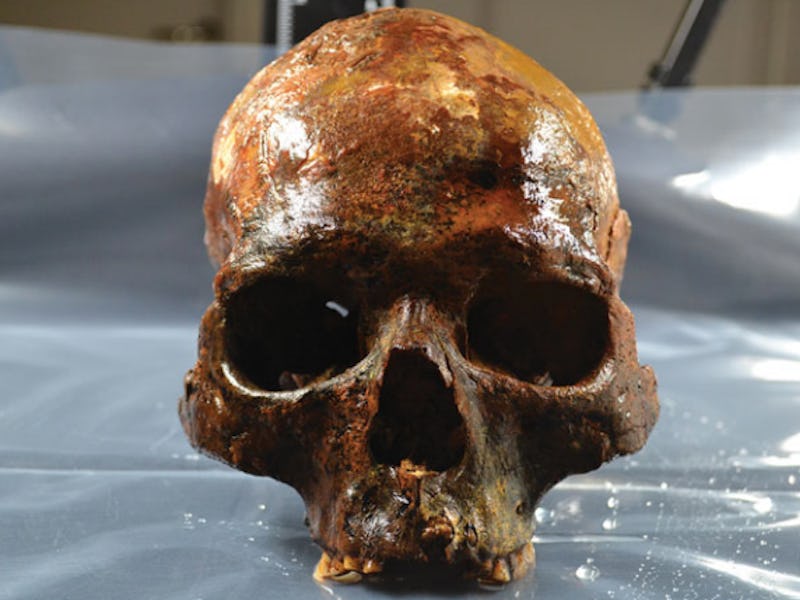Humans Have Been Brutally Mounting Skulls on Stakes for Over 8,000 years
A grisly discovery reveals a gruesome ancient ritual.

At the bottom of a small lake in eastern-central Sweden, scientists have uncovered some of the earliest known examples of a type of brutality seen only in the most gruesome films. The excavation site, known as Kanalijorden, is a wetland close to the river Motala Strom, where scientists found human remains, along with remnants of animals and Mesolithic tools, in 2011. Now, a new analysis of the remains, which date back to 8,000 B.C.E., shows that the adults entombed in the water experienced severe trauma, and at least two of adult skulls were mounted above the grave — on stakes.
Scientists have established that ancient humans began to colonize Scandinavia around 11,300 B.C., and by 9,000 B.C. semi-sedentary hunter-gatherers filled the northern region. But what researchers are still looking to understand is what Mesolithic society was like during this time: Burial sites often provide clues about culture, but to date, only 200 Mesolithic human burials have been found in Scandinavia.
That’s why the discovery of 11 humans and one infant in Kanalijorden is so extraordinary, archeologists from Stockholm University and the Cultural Heritage Foundation explain in a paper in the journal Antiquity. The presentation of the remains, all with signs of trauma, suggests for the first time that these people practiced complex — and violent — rituals.
The archeological site Kanaljorden is in red.
As far as scientists could tell before this discovery, burial sites from the Mesolithic era are typically earthly graves in which humans were laid to rest in groups. Kanalijorden paints a very different picture: Analysis of the remains suggests that the crania of the victims were injured, the victims later died, and then the crania were brought to the small lake and deposited on a wood-and-stone structure in the water. How exactly the victims came to die is still a mystery: The majority of the cranial remains suggest that the individuals had healed, at least in part, from their injuries, a detail the study authors write suggests “seems to be more than a coincidence and implies that they were specifically chosen for inclusion in the deposition.”
Osteological analysis also revealed that there was a sex-related difference to how these people experienced trauma to their head: Women, it appears, were hit on the back of the head, while the men were hit on the top. Because all of the blunt force trauma and depressed fractures on the crania are located above the hat brim line, the archeologists say it’s much more likely these injuries are a result of purposeful acts of violence. Each of the skulls, regardless of gender, were removed of their mandibles before burial.
A cranium with a wooden stake.
But perhaps the most novel discovery made at this watery grave was that two of the crania were found with stakes embedded within them — evidence that they were once mounted. The archeologists also found 400 intact and fragmentary wooden stakes around the site and believe other skulls, animal remains, and artifacts were similarly mounted. “These events do not appear to be random,” the archeologists write, “but rather are a series of conscious choices.”
Why these conscious choices were made, however, is a mystery. The archeologists hypothesize that these victims were selected because they were part of a stigmatized group, like slaves. However, slavery was very rare among mobile hunter-gatherers like the Mesolithic people who did this, and it would have been a major logistical challenge for them to keep captives. The brutality evidenced in this burial is also strange, as hunter-gatherers aren’t known for mounting skulls or violent funeral rituals.
“The intentional removal of mandibles and the separation of the skull from the body stand in contrast to reported Mesolithic burial practices in Northern Europe, where bodily integrity was often respected after interment in primary earthen burials,” the archeologists write.
This discovery also raises the question of whether the bones found in other Mesolithic sites, especially those discovered in lakes and bogs, are the result of similar rituals. Further excavation and analysis will hopefully reveal whether this was the norm — or if the ancient people who did these were just especially brutal.